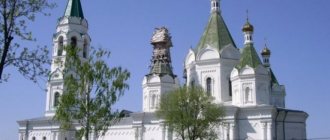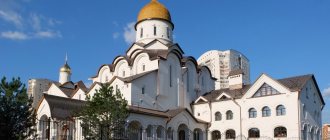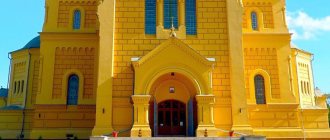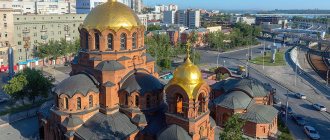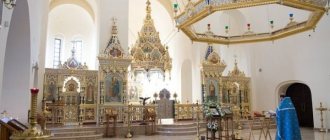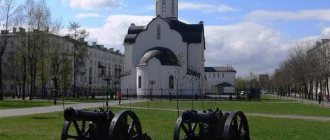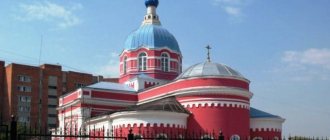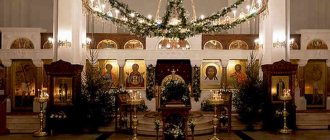| Volgograd Kazan Cathedral |
Volgograd and Kamyshin diocese
of the Volgograd Metropolis of the Russian Orthodox Church
- Diocesan administration: Russia, 400012, Volgograd, st. Chapaeva, 26
- Tel., 36-86-06
- Official site:
- Canonical territory: Volgograd, Volzhsky and Kamyshinsky GO; Gorodishchensky, Dubovsky, Kamyshinsky, Kotovsky districts of the Volgograd region.
- Cathedrals: Kazansky in Volgograd, Nikolsky in Kamyshin
- On the map: Yandex.Map, Google map
Since 1261, the lands of the modern Volgograd region belonged to the Sarai diocese, from 1555 to the Kazan diocese, and from 1606 to the Astrakhan diocese.
In 1799, local parishes became part of the newly established Saratov diocese, which in 1803 was transformed into the Penza diocese. In 1828-1918 - again under the jurisdiction of the Saratov department. The Tsaritsyn diocese was created in 1918. According to some sources, at first it was a vicariate of Saratov, but later became independent. The diocese ceased to exist in the second half of the 1930s.
In the 1920-30s there was a Stalingrad renovationist diocese.
On July 8, 1943, the Stalingrad diocese (within the Stalingrad region) was entrusted to the Saratov bishop for parallel management of both departments.
From June 26, 1944 to July 15, 1959, the Stalingrad region was part of the Astrakhan diocese, after which it was transferred to the Saratov diocese.
On January 31, 1991, it was revived as an independent diocese, having been separated from Saratov. The boundaries of the diocese were determined along the boundaries of the Volgograd region.
On March 15, 2012, the independent Uryupinsk and Kalachevsk dioceses were separated from the Volgograd diocese, after which the Gorodishchensky, Dubovsky, Kamyshinsky and Kotovsky districts, as well as the Volgograd, Volzhsky and Kamyshinsky urban districts in the middle part of the Volgograd region remained under the jurisdiction of the Volgograd department. At the same time, the Volgograd See became the center of the newly established Volgograd Metropolis.
Historical names
- Tsaritsynskaya (1918 - 1925)
- Stalingrad (1925 - ?)
- Volgogradskaya (since 1961)
- Volgogradskaya and Kamyshinskaya (since January 31, 1991)
Statistics
- 1944 - 16 churches and houses of worship in the Stalingrad region.
- 1945 - 25 operating churches and houses of worship in the Stalingrad region.
- 1947 - 42 operating churches and houses of worship in the Stalingrad region.
- January 31, 1991, at the time of re-establishment - 43 parishes, 72 clergy [1]
- 2003 - 190 churches, 6 monasteries [2]
- January 1, 2011 - 303 active parishes (of which 73 are in Volgograd, 18 are prison); 286 clergy (of which 262 presbyters, 24 deacons); 9 monasteries; in the monasteries there are 26 robed monks, 63 robed nuns, 6 monks, 14 nuns [3]
- October 1, 2012 - 2 monasteries; 15 robed monks, 22 robed nuns, 4 nuns; 126 operating parishes (of which 75 are in Volgograd), incl. 10 prison (of which 6 are in Volgograd); 137 clergy, incl. in the rank of priest - 121 (1 archimandrite, 5 abbots, 10 hieromonks, 41 archpriests, 64 priests), 16 deacons (3 protodeacons, 9 deacons, 4 hierodeacons) [4]
- November 20, 2013 - 2 monasteries; 12 robed monks, 22 robed nuns, 4 nuns; 130 operating parishes (of which 78 are in Volgograd), including 10 prison parishes (of which 6 are in Volgograd); 139 clergy, incl. in the rank of priest - 120 (1 archimandrite, 6 abbots, 11 hieromonks, 35 archpriests, 67 priests), 19 people. in the diaconate (4 protodeacons, 12 deacons, 3 hierodeacons) [4]
The Tsaritsyn diocese appeared in 1918, it was headed by Bishop Damian
During the years of the revolution, approximately six hundred parishes operated on the territory of the modern diocese. In order to centralize administration at the regional level, Patriarch Tikhon created the Tsaritsyn diocese, at the head of which he placed Bishop Damian (Govorov) of Petrovsky.
Bishop Diaman (Govorov) - the first head of the Tsaritsyn diocese
This Orthodox figure was born on February 11, 1855. The father was a priest, so his son naturally received a spiritual education and began to serve in Crimea, then moved to Kyiv, and then to Chisinau. In the summer of 1917, Father Damian was appointed vicar of the Saratov region, and in 1918 he was called to head the Tsaritsyn diocese.
But already in 1919 - 1920, Bishop Damian, as a supporter of the white movement, was forced to leave the country. In Europe, he achieved the rank of archbishop for his services to the Church and died in 1936.
Story
The original Russian Orthodox lands of modern Volgograd and the region were initially part of the Sarsk diocese, and after 1555 they became part of the Kazan diocese. However, almost immediately after the founding of the Tsaritsyn fortress, the number of parishes began to increase and a decision was made to create a new Astrakhan branch of the Russian Orthodox Church.
Kazan Cathedral in Volgograd
It was to him that all the temples and monasteries that were located along the Volga, starting from Saratov and ending with the southern regions near the banks of the Don, were assigned. In 1918, His Holiness Patriarch Tikhon established the Tsaritsyn diocese and appointed Bishop of Petrovsky Damian (Govorov) as the ruling bishop.
At the end of 1919, he left the city, was evacuated to Crimea, moved through Constantinople to Bulgaria, where on April 19, 1936 he died in the rank of Archbishop of Tsaritsyn. The revolution and the coming of the Bolsheviks to power caused serious damage to the entire Russian Orthodox Church, the Volgograd region was no exception.
In 1918, the authorities closed the religious school in Kamyshinsk, and 2 years later in Ust-Medveditsk. In the fall of 1922, almost all monasteries throughout the region were liquidated.
Subsequent bishops 1920-1940 did not hold this position for more than a couple of years - most of them were repressed and shot, and also sent into exile by the USSR government during the “Red Terror”. The former hieromonk Sergei Trufanov also stood out, who in 1921 founded a religious sect in Tsaritsyn, recognized the Bolsheviks as the new government and declared himself the All-Russian Patriarch.
In 1922 he fled abroad, but his actions marked the beginning of various heresies in the area and constant schism and disagreement within the clergy.
In the summer of 1922 in Tsaritsyn, with the support of local Bolshevik authorities, a group of priests who called themselves renovationists announced the creation of their own administration. The “Provisional Church Administration” was headed by Bishop Modest (Nikitin) of Ust-Medveditsk and immediately launched a campaign against the current Bishop Nifont (Fomin).
The Bolsheviks accused Nifont of misappropriating and concealing church values and arrested him, later sentencing him to death. Volgograd was renamed Stalingrad and in the city for 10 years (1920-1930) there were parallel parishes of the Russian Orthodox Church and various renovationists.
Uryupinsk icon of the Blessed Virgin Mary in the Intercession Church
The latter had the support of the authorities and led 360 parishes, while the priests of the Russian Orthodox Church, on the contrary, were subjected to numerous repressions and in 1925 had only 35 parishes. In the first 20 years of rule alone, the Bolsheviks managed to close about 580 churches and repress more than 1,000 clergy and monks.
In such conditions, Archbishop Peter (Sokolov) in 1930 decided to hold services around the clock and even in private apartments, so that people had the opportunity to hear the Word of God, since the last church of the Russian Orthodox Church was closed that year. The archbishop was arrested in 1935 and a year later he died in prison, and his place in the administration of the Stalingrad region was taken by Archbishop Gregory (Chukov).
During World War II, Stalingrad and the region were seriously damaged, so it was only in 1944 that a new archbishop, Philip Stavitsky, came. By 1947, 40 churches were under his control, but at the end of the 1950s repressions began again and in 1959 the diocese lost its independence and became part of Saratov.
The Soviet government tried to destroy the diocese - directly and with the help of Hieromonk Iliodor
Soviet power hit the Tsaritsyn diocese hard. Atheists destroyed monasteries and closed two large religious schools:
- Kamyshenskoe;
- Ust-Medveditskoye.
Another blow was dealt by Hieromonk Iliodor, an extraordinary personality in the history of our country. He was a radical man, a hater of Jews and intellectuals. This monk had oratorical abilities and always went against the higher clergy. But Iliodor was not afraid of anything, since he was supported by Grigory Rasputin.
Hieromonk Iliodor was banned from serving and ordered to be arrested, but all this did not produce results. The monk was not even afraid of his patron, Rasputin.
Hieromonk Iliodor, who was banned from serving, made a lot of efforts to harm the Tsaritsyn diocese
This narcissistic man willingly gave interviews and tried to remain visible, as he knew how to convince the masses. In 1918, fate once again brought Iliodor to Tsaritsyn, where he organized the “Eternal Peace” sect.
With the support of the atheistic authorities, Iliodor confused the people and tried to proclaim himself the patriarch of the country, but he did not achieve success and in 1922 he fled abroad, however, from there he continued to plot the machinations of the Russian Orthodox Church. He died in 1952.
Renovationists have become a new weapon of the atheistic authorities against the Orthodox diocese
The baton of unrest was taken up by the Renovationists, the main opponents of traditional Orthodoxy. They sought to find a compromise with the current government and were given the opportunity to create the “Temporary Church Administration of the Tsaritsyn Diocese.”
It was led by Bishop Modest (Nikitin) of Ust-Medveditsky, who immediately organized a campaign against Bishop Nifont (Fomin), who was indifferent to politics. It all ended with his arrest, which was far from the only one in his life. Date of death unknown.
Bishop Nifont (Fomin) was arrested to weaken the diocese
Since then, representatives of traditional Orthodoxy have been forced to coexist alongside renovationist organizations. For comparison, the renovationists controlled 360 parishes, and their opponents had ten times fewer.
In 1925 the diocese was renamed Stalingrad.
The advantage in the number of parishes very quickly depreciated, as the Soviet government began to close all churches. The clergy themselves also suffered: they were arrested for the most flimsy reasons.
VOLGOGRAD AND KAMYSHIN DIOCESE
In 1918, by the decision of the Patriarch of Moscow and All Russia, St. Tikhon (Bellavina) and the Synod within the boundaries of the emerging Tsaritsyn province, established on September 7. the same year. The Tsaritsyn Vicariate was created. The former Tsaritsyn bishop was appointed. vicar of the Saratov diocese, Bishop of Petrovsky. Damian (Govorov). (In 1914, on the territory of Bud. V. and K. E. there were 7 mon-rays and about 600 temples, in Tsaritsyn - 16 temples, in 1918 the consecration of the Alexander Nevsky Cathedral in the city center took place.)
The organization of church life in the newly formed diocese was hampered by the fact that since the autumn of 1917 the N. Volga and Don had been the scene of fierce battles. On June 30, 1919, Tsaritsyn was taken by the Caucasian Army, General. A. I. Denikina. In Aug. 1919 bishop Damian convened a meeting of the clergy, at which the issue of providing assistance to the clergy who arrived from the places occupied by the Bolsheviks was considered, in addition, a decision was made to organize a pastoral and theological school. The school was created by the bishop. Damian in evacuation in Stavropol (Aug. - Oct. 1919), in November. the same year continued work in Tsaritsyn. 3 Jan 1920 Red Army units entered the city. In con. 1919 bishop Damian and part of the clergy, together with detachments of the White Army, left Tsaritsyn, after. The bishop ended up in Bulgaria, where on April 19. 1936 Died in the rank of Archbishop of Tsaritsyn.
Panorama of Tsaritsyn from the Volga embankment. In the center is the Assumption Cathedral. Photo. Beginning XX century (RGBI) Panorama of Tsaritsyn from the Volga embankment. In the center is the Assumption Cathedral. Photo. Beginning XX century (RGBI) After the establishment of Soviet power in Tsaritsyn, the decree “On the separation of church from state and school from church” began to be implemented. The first attempts to implement this decree in the region were made during the Civil War; in 1920, corresponding provinces were created for this purpose. and county commissions. In 1918, the authorities closed the Kamyshinsky district educational institution, and in 1920, the Ust-Medveditsky educational institution. In May 1921, a cleric of the Ascension Church was shot on charges of counter-revolutionary activities. prot. Alexy Lebedev and the rector of the Assumption Cathedral, Archpriest. Jacob Gorokhov, in June - priest. Venedikt Ostrovidov, in August - Hierom. Matthew (Oleynik) and priest. Joseph Vavulin. By Aug. 1921 at religious. Tsaritsyn's organizations were confiscated all funds and property, which were recognized as “non-religious”. Oct 9 In 1922, the mon-ri diocese was closed.
In 1921-1922 Tsaritsyn province, like other Volga regions, suffered severely from famine. A campaign was held in the province to confiscate church valuables to help the starving. Despite the readiness of the Tsaritsyn bishop. Nifont (Fomin) to give away all church valuables not used in worship for the purchase of food, the authorities took repressive measures. Ep. Nifont, vicar of the Don diocese, Nizhnechirsky bishop. Nikolai (Orlov) and 15 priests were arrested on charges of concealing valuables, bishop. Nikolai was shot.
In the starving Tsaritsyn province. Renovationism, supported by the authorities, became widespread; schismatics demagogically accused the highest church leadership, diocesan authorities and the Orthodox Church. The clergy is that they prevent the confiscation of church valuables and do not help the starving. In the initial period of the schism, renovationism was associated by contemporaries with the name of Iliodor (see S. T. Trufanov), who came from abroad to Tsaritsyn in 1917, preached “renewal and restoration of religion... restoration of the living Church of Christ” and organized in the city in 1921 agricultural commune. However, the renovationists dissociated themselves from Iliodor and his supporters. In June 1922, a group of renovationist Tsaritsyn clergy announced the creation of the “Provisional Church Administration of the Tsaritsyn Diocese” headed by Modest (Nikitin). Oct 30 1922 g. The management department registered a branch of the “Living Church” under the name “Tsaritsyn Diocesan Administration” (CEU), which the authorities recognized as the only legal church. organization in the region. Aug 26 1924 CEU dismissed 22 clergy in Tsaritsyn and Dubovka. In April In 1923, a renovationist diocesan congress was held, at which the composition of the CEU was approved and delegates were elected to the council in Moscow, which was supposed to depose Patriarch Tikhon. In 1925, 35 Orthodox churches operated on the territory of the Stalingrad diocese. parishes and 360 renovation communities.
Church in the name of St. John the Baptist in Volgograd. Photo. 2004
Church in the name of St. John the Baptist in Volgograd. Photo. 2004
In the 20-30s. XX century There was a massive closure of churches in the region. In 1929, the Alexander Nevsky Cathedral (exploded in 1932), St. Nicholas and Sorrow Churches were closed in Stalingrad, in 1932 the Sergius, Intercession, St. John the Baptist Churches, the Assumption Cathedral were closed, in 1938 the Exaltation of the Cross Church, in 1939 - Alekseevskaya and Kazan churches, in 1940 - Nikitskaya church. By Jan. 1 1940 in the Stalingrad region. closed ok. 580 temples. Under these conditions, services in the surviving churches of Stalingrad by order of the archbishop. Peter (Sokolov) took place around the clock. The Bishop gave priests antimensions and allowed them to serve in the apartments of parishioners; Stalingrad priests went to serve in villages. Donations were collected among the clergy and believers for the arrested clergy.
After 1937, the Stalingrad department was not replaced. In 1942-1944. The diocese was ruled by the Saratov and Stalingrad archbishop. Grigory (Chukov). In April 1944 in the Stalingrad region. There were 18 priests and 18 churches left (one of them was Renovation - in the city of Uryupinsk). June 26, 1944 parishes of the Stalingrad region. were subordinated to the Astrakhan archbishop. Philip (Stavitsky), who began to be titled Astrakhan and Stalingrad (formally the diocese continued to exist). In Aug. In 1944, the renovationist schism was finally overcome in the diocese. In Feb. In 1945, a delegation from the Local Council of the Russian Orthodox Church visited Stalingrad (held January 31 - February 2, 1945). On June 23, 1949, Patriarch Alexy I visited the Stalingrad diocese.
Soon after the end of the Battle of Stalingrad, on May 8, 1943, a temple in the name of St. Nikita the Confessor, July 27, 1945 - Kazan Cathedral. In 1945 in the Stalingrad region. There were 25 parishes, in 1947 there were 42 parishes. In 1943-1946. 261 applications for the opening of churches were submitted, 26 temples and houses of worship were opened. Sunday services in the Kazan Cathedral of Stalingrad were attended by up to a thousand people, on the Twelfth holidays - up to 8 thousand. In 1945-1947. in Uryupinsk, for the feast of the Uryupinsk Icon of the Mother of God on June 21, up to 15 thousand believers from Stalingrad, Voronezh, Rostov, Saratov, Ryazan, Tambov and other regions, as well as from the Ukrainian SSR, gathered. Soviet authorities noted that Orthodox. The clergy “strenuously inculcates the preaching of the Gospel teaching,” takes care of the beauty of worship, the organization of church choirs, and the repair and painting of churches. In 1956, 13,555 thousand rubles were spent on repairs and decoration of existing churches in the region.
In con. 50s a new stage of persecution of the Church began (see article N. S. Khrushchev). A number of churches were destroyed, and the number of parishes was reduced. 18 Nov 1957 The Stalingrad City Executive Committee decided to dismantle the former buildings. Volgograd in honor of the Descent of the Holy Spirit on the Apostles of the monastery. On July 15, 1959, the Stalingrad diocese was abolished, its parishes were annexed to the Saratov diocese, and the area began to be called “Saratov and Stalingrad.” In con. In 1959, 28 churches and houses of worship were registered in the Stalingrad region, which became the deanery district of the Saratov diocese.
In the 40s, the diocese lost many parishes, and it was merged with Saratov
In 1943, Archbishop Gregory (Chukov) of Saratov, a man of scientific disposition, took charge of the diocese of the Stalingrad region.
In 1944, all Saratov parishes were placed under the authority of Archbishop Philip (Stavitsky) of Astrakhan and Stalingrad.
January 31, 1991
The Volgograd diocese was revived
In the post-war years, persecution of the Church resumed. The number of parishes, of which there were approximately forty at that time, was declining. There was almost nothing left of the diocese, so it was merged with Saratov.
The diocese was revived in 1991 and the Volgograd Metropolis was formed
Only in 1991, on January 31, the diocese was revived.
Over the next eleven years, the number of parishes grew so much that the Holy Synod ordered the organization of several dioceses:
- Volgograd and Kamyshin diocese;
- Kalachevskaya and Pallasovskaya diocese;
- Uryupinsk and Novoanninsk diocese.
Instead of the previous diocese, the Volgograd Metropolis appeared.
Today, the Volgograd diocese itself includes about twenty parishes.
Russian Orthodox Church
Part of the Volgograd Metropolis
Since 1261, the lands of the modern Volgograd region were part of the Sarsk diocese, and since 1555 they belonged to the Kazan diocese. In 1602, shortly after the founding of the Tsaritsyn fortress, the Astrakhan diocese was created, to which, from 1606, all the churches “along the Volga, starting from Saratov to the south, along the Medveditsa and Khopru to the Don” were assigned. In 1799-1918. local parishes were part of the Saratov diocese, which was called in 1803-1828. Penza-Saratov, and from November 3, 1828 - Saratov and Tsaritsyn.
A separate Tsaritsyn diocese was created in 1918, and since 1925 - the Stalingrad diocese. On July 15, 1959, the parishes of the diocese were included in the Saratov diocese. The newly established diocese was called Saratov and Stalingrad (after the renaming of Stalingrad in 1961 - Saratov and Volgograd). On January 31, 1991, an independent diocese, the borders of which coincide with the borders of the Volgograd region, was renewed as Volgograd and Kamyshin.
Cathedral city - Volgograd.
By the decision of the Holy Synod of March 15, 2012 (magazine No. 4), the Kalachevsk and Uryupinsk dioceses were separated from the diocese. The Volgograd diocese is included in the Volgograd Metropolis.
Diocese today (as of November 20, 2013)
Deaneries and deaneries
- Southern Volgograd - Archpriest Sergius Tyupin
- Second Volgograd - priest Alexy Zimovets
- Central Volgograd - Archpriest Nikolai Babak
- Northern Volgograd - priest Alexander Simonchuk
- Dubovskoe - Archpriest Vladislav Sologub
- Kamyshinsko-Kotovskoe - Archpriest Anatoly Karpets
Monasteries
- Holy Spirits Men's 400012, Volgograd, st. Chapaeva, 26; tel. (8442) 39-66-67 rector - abbot Gabriel (Kulikov)
- Holy Ascension Women's 404002, Volgograd region, Dubovka abbess - Abbess Anna (Erofeeva)
The following people live in the monasteries of the diocese:
- robed monks - 12;
- robed nuns - 22;
- nuns - 4.
active parishes (including 10 prison ones). In Volgograd there are 78 parishes (including 6 prison ones).
clergy , of which 120 are in the rank of priest and 19 in the rank of deacon. Of them:
- archimandrites - 1;
- abbots - 6;
- hieromonks - 11;
- archpriests - 35;
- priests - 67;
- protodeacons - 4;
- deacons - 12;
- hierodeacons - 3.
Social institutions
- Boriso-Glebskoye family-type children's village 400107, Volgograd, Marshal Zhukov Avenue, 77; tel. (8442) 54-14-59
- hospice house of St. Seraphim of Sarovsky for the elderly 400010, Volgograd, st. Tishchenko, 18; tel. (8442) 37-15-33
Diocesan media
- "Orthodox Word" (monthly newspaper)
- official website of the Volgograd diocese
Educational establishments
- Tsaritsyn Orthodox University, St. Sergius of Radonezh 400012, Volgograd, st. Chapaeva, 26, Holy Spirit Monastery; Tel. Rector - Metropolitan German of Volgograd and Kamyshin
- Volgograd Diocesan Theological School (operates at the university as a preparatory department) 400012, Volgograd, st. Chapaeva, 26, Holy Spirit Monastery; tel. (8442) 32-76-98 director - priest Vladimir Tupikov
In the Volgograd diocese there is a miraculous icon of the Mother of God and holy springs
Orthodox Volgograd has its own shrines. One of the most revered is the miraculous Uryupinsk Icon of the Mother of God. It is kept in the Uryupinsk Church in honor of the Intercession of the Blessed Virgin Mary.
This icon was discovered on June 8, 1827, after which the ascetic Irina Lazareva kept it in her cell. According to her testimony, the icon immediately healed her friend, who had been ill for almost a quarter of a century, from an illness.
The miraculous Uryupinsk Icon of the Mother of God
Subsequently, many people dreamed of the icon, and these people also received healing.
As a result, in 1854, the icon was moved to its current location, where it continued to save people from terrible diseases.
According to legend, there was a healing spring where the icon was found. The Bolsheviks tried to bury him, but they failed.
Source of the Uryupinsk Icon of the Mother of God
There are other especially revered sources in the Volgograd diocese:
- Apostle John the Theologian;
- Great Martyr Paraskeva Friday;
- Kazan Icon of the Mother of God;
- Archangel Michael;
- Saint John the Baptist.
Current state
In the winter of 1991, the Holy Synod allocated a separate Volgograd diocese, headed by Bishop German (Timofeev). Volgograd remained the cathedral city, and Kazan (Volgograd) and Nikolsky (Kamyshin) cathedrals became cathedrals.
When the territorial unit was restored, 18 parishes and 5 monasteries immediately opened, but their growth was so rapid that after 11 years, in 2012, the Synod decided to create the Volgograd Metropolis for greater efficiency of regional administration and divide it into several parts:
- Volgogradskaya;
- Kalachevskaya;
- Uryupinskaya;
- Kamyshinskaya;
- Pallasovskaya;
- Novoanninskaya.
Service of Volgograd Metropolitan Theodore in the Kazan Cathedral
After the division, only about 20 parishes remained in the Volgograd diocese and they are led by Bishop Theodore (Cazanov), who also heads the metropolis of the same name.
Both monasteries of the Volgograd diocese were closed for almost the entire 20th century
There are two old monasteries on the territory of the Volgograd diocese:
- Holy Ascension Dubovsky Monastery. Women's monastery. It was founded in 1871 in the vicinity of Tsaritsyn using donations. It accommodated almost three hundred people, but after the revolution the monastery was closed. The temples there were destroyed. Only in 1991 the activity of the monastery was resumed.
Holy Ascension Dubovsky Monastery (Dubovka)
- Volgograd Monastery in honor of the Descent of the Holy Spirit on the Apostles. Initially, in 1908, a bishop's courtyard was formed here. And in 1912 this place was converted into a monastery. It is notorious for the fact that Hieromonk Iliodor preached here. In 1913, the monastery was converted into a women's monastery, and in 1923 it was closed. The Soviet government took away the buildings for its own needs. In 1992, the monastery was revived. Now he is male again.
Volgograd Monastery in honor of the Descent of the Holy Spirit on the Apostles
Yakov Gorokhov - a local priest who was canonized
Hieromartyr Yakov Gorokhov was born in 1880 and subsequently became an active religious figure in the early 20th century. He came from a family of clergy and was a deeply spiritual man.
Father Yakov's main activity is missionary work. He preached in the Saratov diocese and studied sects there. He also taught at the Kamyshin School.
In 1916, Yakov Gorokhov was transferred to Tsaritsyn, where he worked with wounded soldiers and collecting donations for military needs.
Saint Yakov Gorokhov was the dean of Tsaritsyn
Father took a negative view of the revolution. He publicly, at a sermon, declared that he would remain a supporter of the king, as is prescribed for a priest. He was arrested, but was not held in custody for long.
In 1917, Yakov Gorokhov became dean of the city of Tsaritsyn. For some time he served in several churches at once due to a lack of priests.
For supporting the white movement, the priest was arrested by the Bolsheviks. On May 31, 1921, he was arrested. The Russian Orthodox Church abroad canonized Yakov Gorokhov.
UNITED PILGRIMAGE CENTER
Dear Pilgrims!
We draw your attention to the statement of the Holy Synod of the Russian Orthodox Church, made on October 17, 2021, about the situation that has developed in the Greek Orthodox Church after the extraordinary Council of Bishops on October 12, 2021 on the Ukrainian church issue (magazine No. 125).
Members of the Holy Synod of the Russian Orthodox Church got acquainted with the documents published in the media of the extraordinary Council of the hierarchy of the Greek Orthodox Church dated October 12, 2021, in particular, with the communique of the Council and with the report of His Beatitude Archbishop Jerome of Athens and All Greece “Autocephaly of the Church of Ukraine”, in which it is proposed to “recognize... the autocephaly of the Orthodox Church of the independent Ukrainian Republic.”
The statement of the Holy Synod of the Russian Orthodox Church says:
“It is sad that in this way the historical merits of the Greek people in the spread of Orthodoxy are exchanged for momentary political benefits and support for geopolitical interests alien to the Church. But these speculations on national feelings will not be successful. They will not be able to undermine the unity of our faith, purchased with the blood of the new martyrs and confessors of our Churches. They will not interrupt the unity of our ascetic tradition, created by the exploits of many reverend fathers and ascetics. They will not destroy the centuries-old friendship of the Greek and Slavic peoples, paid for with the blood of Russian soldiers and tempered in the common struggle for the freedom of the fraternal Greek people.
— At the same time, we remember that the sacred canons of the Church condemn those who enter into prayerful communion and concelebration with those defrocked and excommunicated (Apostle 10, 11, 12; I Om. 5; Antioch. 2, etc.) . In this regard, we are ceasing prayerful and Eucharistic communion with those bishops of the Greek Church who have entered or will enter into such communion with representatives of Ukrainian non-canonical schismatic communities. We also do not bless pilgrimage trips to dioceses governed by the above-mentioned bishops. Relevant information will be widely distributed among pilgrimage and tourism organizations of the countries that make up the canonical territory of our Church.
The Holy Synod of the Russian Orthodox Church authorizes His Holiness Patriarch Kirill of Moscow and All Rus' to stop commemorating the name of His Beatitude the Archbishop of Athens and all of Greece in diptychs if the Primate of the Greek Church begins to commemorate the head of one of the Ukrainian schismatic groups during services or takes other actions indicating recognition has taken place them of the Ukrainian church schism,” the archpastors said.
The full text of the document can be found on the website of the Moscow Patriarchate.
The Holy Synod took measures in connection with the recognition by the Primate of the Alexandria Patriarchate of a schismatic structure in Ukraine
As the members of the Holy Synod emphasized in their decision: “The decision of Patriarch Theodore of Alexandria to recognize Ukrainian schismatics contradicts the repeated statements of His Beatitude in support of the canonical Ukrainian Orthodox Church and its Primate, Metropolitan Onufry of Kiev and All Ukraine, including those made during his last visit to the Ukrainian Orthodox Church on September 27 - October 1, 2021, three weeks after the invasion of the Patriarchate of Constantinople into Ukraine through the appointment of “exarchs” to Kyiv,” the resolution of the Holy Synod says.
Also, members of the Holy Synod pointed out that the decision to recognize the schismatic structure in Ukraine was not made at the meeting of the Holy Synod of the Patriarchate of Alexandria on October 7-9, was not submitted to a vote of its bishops and, accordingly, does not have a conciliar character, but was adopted by the Primate of this Churches alone.
The Holy Synod confirmed the impossibility of commemorating the name of Patriarch Theodore of Alexandria in diptychs, as well as prayerful and Eucharistic communion with him. At the same time, it was decided to maintain church communion with the bishops of the Alexandrian Orthodox Church, except for those who supported or in the future will support the legalization of the Ukrainian schism.
Among other measures taken by the Holy Synod regarding the Church of Alexandria are the suspension of the activities of the representation (metochion) of the Alexandria Patriarchate under the Moscow Patriarchal Throne and the transformation of the representation of the Patriarch of Moscow and All Rus' under the Patriarch of Alexandria into the parish of the Russian Orthodox Church in Cairo.
In addition, it was decided to remove from the jurisdiction of the Alexandrian Patriarchate the parishes of the Russian Orthodox Church located on the African continent, giving them stauropegial status.
Journal of the meeting of the Holy Synod on the website of the Moscow Patriarchate
The Russian Orthodox Church has declared it impossible to remain in Eucharistic communion with Constantinople
The actions of the Patriarchate of Constantinople took him outside the canonical field, which made it impossible for the Russian Orthodox Church to continue to be in Eucharistic communion with him, the Holy Synod of the Russian Orthodox Church decided.
“The acceptance into communion of schismatics and a person anathematized in another Local Church with all the “bishops” and “clergy” ordained by them, an encroachment on other people’s canonical inheritances, an attempt to renounce one’s own historical decisions and obligations, takes the Patriarchate of Constantinople beyond the canonical field,” emphasized Synod of the Russian Orthodox Church.
As stated in the decision, all this makes it impossible to continue to remain in Eucharistic communion with its hierarchs, clergy and believers.
From now on, until the Patriarchate of Constantinople refuses the anti-canonical decisions it has made, it is impossible for all clergy of the Russian Orthodox Church to concelebrate with the clergy of the Church of Constantinople, and for the laity to participate in the sacraments performed in its churches.
The Synod also called on the Primates and Holy Synods of the Local Churches to properly evaluate the above-mentioned anti-canonical acts of the Patriarchate of Constantinople and to jointly search for ways out of the grave crisis tearing apart the body of the One Holy Catholic and Apostolic Church.
The full text of the statement of the Holy Synod of the Russian Orthodox Church on the encroachment of the Patriarchate of Constantinople on the canonical territory of the Russian Church can be found on the website of the Moscow Patriarchate.
Orthodox Saint Nicholas Popov was killed for his faith by the Bolsheviks
Another local saint is Nikolai Popov. He grew up in a happy and religious family. Naturally, he himself became a priest. He was an open person who attracted other people to Christianity. He was concerned about issues of spiritual education; in addition, the saint was involved in the improvement of the churches in which he served.
He was always responsive to other people's requests, tried to help and for these purposes expanded his knowledge, for example, about medicine.
Martyr Nikolai Popov served in the Tsaritsyn diocese and died for his faith
Due to the problems of the Church with the new government, Nikolai Popov and the clergy around him felt that they were cut off from other Christians and could only rely on themselves. They were lonely, just as the first Christians were lonely - alone, oppressed by everyone, but devoted to the faith.
Nikolai Popov was first arrested, but even in prison he continued his spiritual activities, as if he were not in prison, but in church. He helped the sick and preached.
Although the priest did not harm anyone, they refused to let him go. His head was smashed and his neck was cut. Believers managed to get the body of Nikolai Popov and bury him with honors.
News and other information are published on the official website of the Volgograd diocese
The Volgograd diocese has an official website. There you can find interviews and sermons of the highest clergy of the entire metropolis, a schedule of services and much more.
Official website of the Volgograd diocese
Those wishing to receive spiritual education can find information about local religious institutions on the website.
The site administration regularly publishes Orthodox news: important events in the life of the diocese, holidays, festivals. For the convenience of users, all information is divided into topics. Those interested can read the news from the youth department, news on the canonization of saints, or something else.
To establish feedback from visitors, new competitions on Orthodox themes are regularly held.
By leaving a comment, you accept the user agreement

